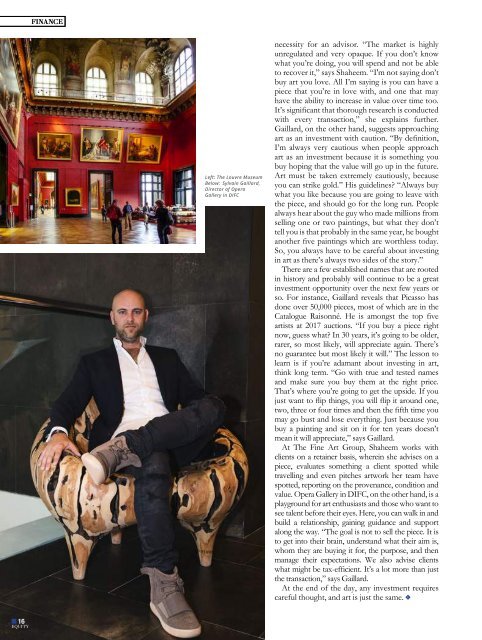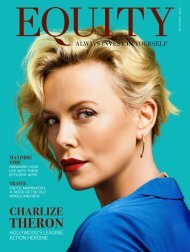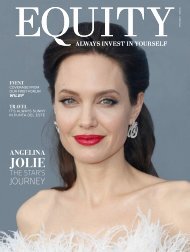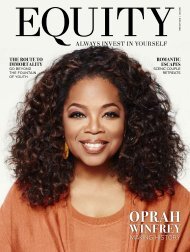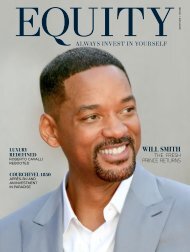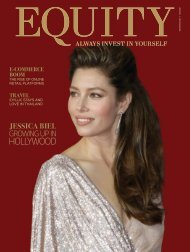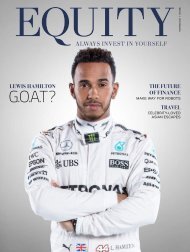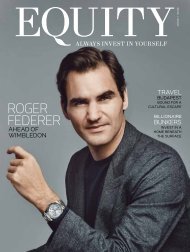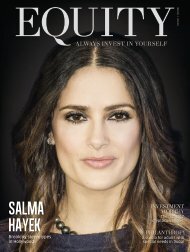Equity Mag Sep_17 Book Folder
You also want an ePaper? Increase the reach of your titles
YUMPU automatically turns print PDFs into web optimized ePapers that Google loves.
FINANCE<br />
Left: The Louvre Museum<br />
Below: Sylvain Gaillard,<br />
Director of Opera<br />
Gallery in DIFC<br />
necessity for an advisor. “The market is highly<br />
unregulated and very opaque. If you don’t know<br />
what you’re doing, you will spend and not be able<br />
to recover it,” says Shaheem. “I'm not saying don’t<br />
buy art you love. All I’m saying is you can have a<br />
piece that you’re in love with, and one that may<br />
have the ability to increase in value over time too.<br />
It’s significant that thorough research is conducted<br />
with every transaction,” she explains further.<br />
Gaillard, on the other hand, suggests approaching<br />
art as an investment with caution. “By definition,<br />
I’m always very cautious when people approach<br />
art as an investment because it is something you<br />
buy hoping that the value will go up in the future.<br />
Art must be taken extremely cautiously, because<br />
you can strike gold.” His guidelines? “Always buy<br />
what you like because you are going to leave with<br />
the piece, and should go for the long run. People<br />
always hear about the guy who made millions from<br />
selling one or two paintings, but what they don’t<br />
tell you is that probably in the same year, he bought<br />
another five paintings which are worthless today.<br />
So, you always have to be careful about investing<br />
in art as there’s always two sides of the story.”<br />
There are a few established names that are rooted<br />
in history and probably will continue to be a great<br />
investment opportunity over the next few years or<br />
so. For instance, Gaillard reveals that Picasso has<br />
done over 50,000 pieces, most of which are in the<br />
Catalogue Raisonné. He is amongst the top five<br />
artists at 20<strong>17</strong> auctions. “If you buy a piece right<br />
now, guess what? In 30 years, it’s going to be older,<br />
rarer, so most likely, will appreciate again. There’s<br />
no guarantee but most likely it will.” The lesson to<br />
learn is if you’re adamant about investing in art,<br />
think long term. “Go with true and tested names<br />
and make sure you buy them at the right price.<br />
That’s where you’re going to get the upside. If you<br />
just want to flip things, you will flip it around one,<br />
two, three or four times and then the fifth time you<br />
may go bust and lose everything. Just because you<br />
buy a painting and sit on it for ten years doesn’t<br />
mean it will appreciate,” says Gaillard.<br />
At The Fine Art Group, Shaheem works with<br />
clients on a retainer basis, wherein she advises on a<br />
piece, evaluates something a client spotted while<br />
travelling and even pitches artwork her team have<br />
spotted, reporting on the provenance, condition and<br />
value. Opera Gallery in DIFC, on the other hand, is a<br />
playground for art enthusiasts and those who want to<br />
see talent before their eyes. Here, you can walk in and<br />
build a relationship, gaining guidance and support<br />
along the way. “The goal is not to sell the piece. It is<br />
to get into their brain, understand what their aim is,<br />
whom they are buying it for, the purpose, and then<br />
manage their expectations. We also advise clients<br />
what might be tax-efficient. It’s a lot more than just<br />
the transaction,” says Gaillard.<br />
At the end of the day, any investment requires<br />
careful thought, and art is just the same.<br />
16<br />
EQUITY


